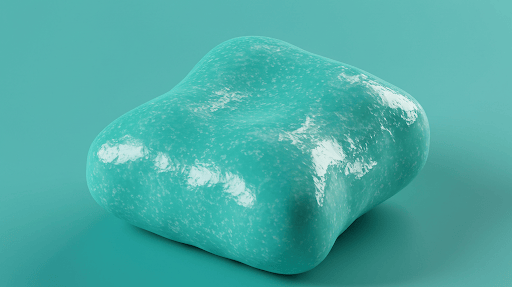Enhancing Chewing Gum Flavor Release and Shelf Life with Fiber: Innovation by Perfetti Van Melle
CONFECTIONARY


This is an AI generated illustration and does not represent actual product or service.
Chewing gum has been a popular confectionery product for decades, offering consumers a refreshing and flavorful experience. However, one of the challenges in chewing gum formulation has been the efficient release of flavor during mastication. Many flavor compounds are hydrophobic and tend to get trapped in the gum base, particularly in the elastomers, making them less available to the consumer during the chewing process. This inefficiency often leads to the need for higher flavor loadings, which can be costly due to the expense of flavor ingredients. To address this issue, Perfetti Van Melle has developed an innovative approach to improve flavor release and retention in chewing gum by incorporating fiber ingredients into the gum composition.
The Problem: Flavor Retention and Release in Chewing Gum
Chewing gum is typically composed of a gum base, sweeteners, softeners, flavors, and other ingredients. The gum base, which provides the chewy texture, contains water-insoluble components like elastomers and resins. These components can trap hydrophobic flavor compounds, preventing their full release during chewing. As a result, a significant portion of the flavor remains in the gum bolus, reducing the overall flavor experience for the consumer.
To compensate for this inefficiency, manufacturers often increase the amount of flavor in the gum. However, this solution is not ideal due to the high cost of flavor ingredients. There is a clear need for a more effective way to enhance flavor release without increasing the cost of production.
The Solution: Incorporating Fiber into Chewing Gum
Perfetti Van Melle’s patent application addresses this challenge by introducing fiber ingredients into the chewing gum composition. The fiber acts as a carrier for the flavor, improving both flavor retention during storage and flavor release during mastication. The patent outlines several key methods for achieving these improvements:
1. Improved Flavor Retention During Storage: By incorporating a fiber ingredient with a high water-holding capacity (WHC) or a combined water-holding and oil-binding capacity, the chewing gum can retain more flavor over time. This is particularly beneficial for extending the shelf life of the product. For example, fibers like citrus pulp fiber and oat fiber have been shown to significantly reduce flavor loss during storage, even when the gum contains 20% less flavor than a control sample.
2. Enhanced Flavor Release During Chewing: Fibers with high water-holding capacity can increase the uptake of saliva into the gum bolus during chewing. This increased moisture helps to extract and release more flavor from the gum, providing a more intense and prolonged flavor experience for the consumer. Fibers like oat fiber and citrus fiber have demonstrated this effect, leading to higher flavor release in the early stages of chewing.
3. Reduced Flavor Loading Without Compromising Flavor Perception: The addition of fiber allows for a reduction in the amount of liquid flavorant used in the gum without sacrificing flavor intensity. This is achieved by improving the efficiency of flavor release, ensuring that the consumer still experiences a strong flavor even with lower flavor loadings. This reduction in flavor usage can lead to significant cost savings for manufacturers.
4. Modified Flavor Release Profiles: The patent also describes a method for modifying the flavor release profile of chewing gum by pre-mixing the fiber and flavor before incorporating them into the gum base. This approach can create a more linear and sustained flavor release, providing a consistent flavor experience throughout the chewing process. This is particularly useful for gums where a prolonged flavor experience is desired.
The Science Behind Fiber’s Role in Chewing Gum
The effectiveness of fiber in improving flavor release and retention lies in its ability to hold both water and oil. Fibers with high water-holding capacity can absorb saliva during chewing, increasing the moisture content of the gum bolus. This enhanced moisture helps to partition the flavor compounds into the saliva, making them more available for release during mastication. Additionally, fibers with high oil-binding capacity can trap hydrophobic flavor compounds, preventing them from being lost during storage and ensuring they are released during chewing.
The patent highlights the importance of selecting the right type of fiber based on its water-holding and oil-binding capacities. For example, fibers like oat fiber and citrus pulp fiber, which have high water-holding capacities, are particularly effective at improving flavor retention and release. On the other hand, fibers with lower water-holding capacities, such as chicory fiber and rice flour, can be used to modify the flavor release profile, providing a more sustained flavor experience.
Practical Applications and Benefits
The incorporation of fiber into chewing gum offers several practical benefits for both manufacturers and consumers:
- Cost Savings: By reducing the amount of flavor needed in the gum, manufacturers can lower production costs without compromising on flavor quality.
- Extended Shelf Life: Improved flavor retention during storage means that the gum maintains its flavor for a longer period, enhancing its shelf life.
- Enhanced Consumer Experience: The increased flavor release during chewing provides a more intense and satisfying flavor experience for the consumer.
- Customizable Flavor Profiles: The ability to modify the flavor release profile allows manufacturers to create gums with different flavor experiences, from quick bursts of flavor to prolonged, sustained releases.
Perfetti Van Melle’s innovative use of fiber ingredients in chewing gum represents a significant advancement in the field of confectionery science. By addressing the challenges of flavor retention and release, this technology not only improves the consumer experience but also offers cost-saving opportunities for manufacturers. As the demand for more efficient and enjoyable chewing gum products continues to grow, the incorporation of fiber ingredients is likely to become a key trend in the industry.


